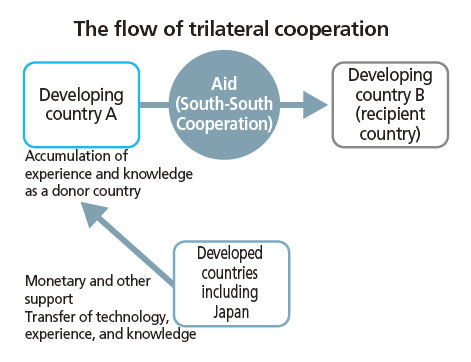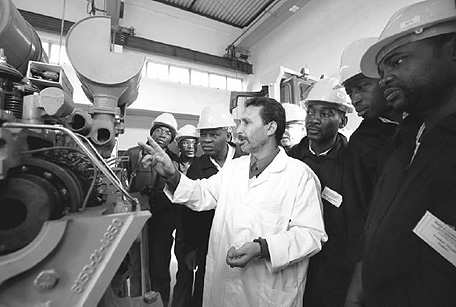Japan's Official Development Assistance White Paper 2011
Keyword 1
South-South Cooperation and Triangular Cooperation
South-South Cooperation refers to cooperation between developing countries for development. It means that one country that is more developed in a certain area assists other developing countries in development of that area. Because most of the more developed countries are in the northern hemisphere, and most developing countries are in the southern hemisphere, the problem of the economic gap between the developed world and developing countries is referred to as the "north-south divide." South-South Cooperation received its name because it refers to cooperation between developing countries (south).
In many cases, the developing country providing assistance in South-South Cooperation has restrictions on its capabilities (insufficient funds, etc.). In such cases, the developed world sometimes supplements that cooperation with technology, funds, experience and knowledge related to aid, etc. This is "North-South-South Triangular Cooperation," in which the developed world (north) also participates in the cooperation between developing countries.
The figure shown here gives an example of the relationship between countries in Triangular Cooperation. A indicates a developing country that provides assistance. B indicates a developing country that receives assistance. Developed nations (Japan, etc.) assist in providing aid from A to B.
Specifically, country A, a developing country that is newly attempting to provide assistance to country B, can utilize its own funds and human resources, as well as the technology, experience, and knowledge that it has fostered, to provide assistance to country B. However, country A is itself still receiving assistance from the developed world, and even if it has the desire to assist country B, it does not necessarily have sufficient funds, human resources, or experience with aid. In such cases, Triangular Cooperation makes it possible for the developed world and international organizations to help the new aid-giving country A with those efforts.
In general, neighboring developing countries tend to have similarities, including language, culture, and climate. If there is a developing country in which technology transferred from Japan or other countries in the developed world has taken root (developing country A), and South-South Cooperation is provided by that country to another similar developing country (developing country B), smooth transfer of technology that is suited to local circumstances will be possible. Further, if this aid from A to B is supported by Japan (or other countries in the developed world), expenses can be kept lower than when Japan provides direct assistance to country B (recipient country), and it is ultimately possible to contribute to the development of more developing countries, with Japan's technology being utilized not only in country A, but in country B as well. Engagement in South-South Cooperation not only allows country A to gain experience, knowledge, and ability as an aid-giving country by standing on the providing side rather than the receiving side, as it had in the past, but also leads to significant confidence in its own history of development.
After World War Two, Japan gained the history and experience of walking the path of growing from an aid-receiving country to a major aid-giving country. One of the lessons learned from that experience is that supporting South-South Cooperation is an effective means of cooperation, and Japan is one of the aid-giving countries that are most proactive in its utilization. The ODA Charter states that "Japan will actively promote South-South Cooperation in partnership with more advanced developing countries in Asia and other regions."


"Triangular Cooperation" in Morocco: Japan provided Grant Aid for building a training center for road maintenance and construction equipment, and provided technical cooperation in Morocco. Training is currently underway for technicians invited from neighboring African countries.(Photo: Shinichi Kuno/JICA)
